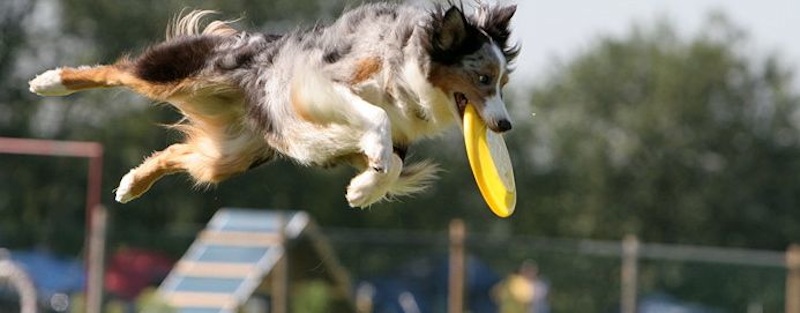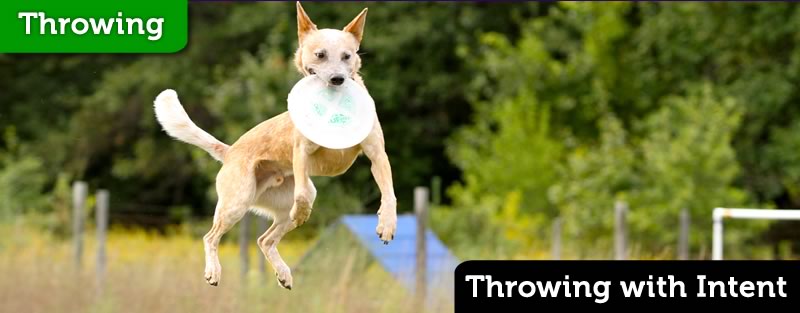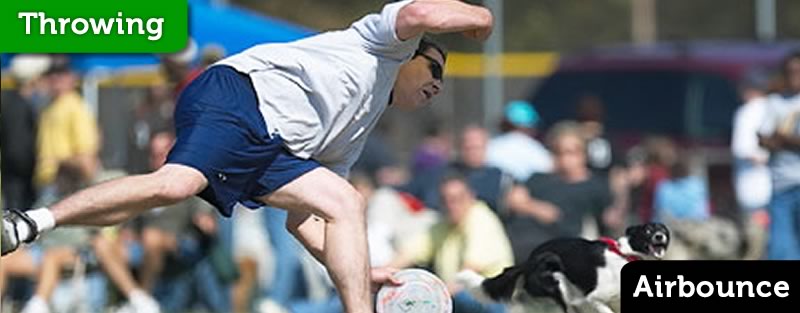
Creative Disc Throw | Airbounce
Forget About Grip and Bounce
Most of the Airbounce instruction out there in the disc dog world focuses on both the grip and the bounce. Your grip is fairly irrelevant and the bounce is counter productive in learning. It’s partly my fault, I put together a video in 2004 or so on throwing the Airbounce that was very authoritative, but not very elegant or effective instruction. It got a bit of ‘black market’ kind of circulation. I see a lot of that old technique in many frustrated discdoggers struggling with the throw.
Master the release by itself and the Airbounce is easy.
Focus on the Release
The key to throwing the Airbounce is to have a perfectly clean release at the simplest expression of the throw. If you can’t perform the throw at it’s essence, how in the world are you going to master it when the power, speed and physics of a serious Airbounce multiply the difficulty? You’re not. That’s why so many people struggle so hard with the throw. Stick with and return to that simple release when you are learning and/or having trouble. This just really cannot be stressed enough. Master the release by itself and the Airbounce is easy. Revisit it frequently to enhance and troubleshoot your performance.
This is a great throw in and of itself, even without the bounce… seriously! It can look very smooth and is really nice for zig zags and multiples. Make sure to put it in your quiver of tricks.
Wing Up
Once you’re trying to bounce the disc, be sure to keep the wing up a bit. Once the disc settles in on the cushion of air you are bouncing the disc off of, the wing needs to drive the disc back up. The wing is the part of the disc that flies towards the target. This is the reason for trying to finish with your thumb pointing down. If the thumb goes down, the knuckles go up. When this happens as you are driving down and towards the target, the bottom of the disc pushes air. You can actually feel it once you get good at it. I know when a checked throw of mine would bounce or not even without releasing it.
Also, when your clean release is working, you can start to mess around with lifting the wing up. The disc will bounce without you pushing down. Make sure you experience this before trying to bounce the disc.
Small Steps and Back Up
The lower and the further away from you that you release the disc, the more it will bounce. Resist the urge to go too far too fast. Make small bounces, like Judy does in the personal instructional portion of the video. If you find yourself experiencing poor bouncing performance (throwing it into the ground, curves, wobbly releases…) go back to the simple release or to a lesser expression of the bounce. Again, this cannot be stressed enough.
Getting Started – Backhand Bounce
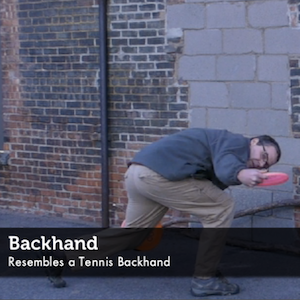 You want to start with the Backhand
You want to start with the Backhand The Backhand toss is the traditional disc throw. While it might not be the easiest throw of them all, it is the easiest to throw a hundred yards, and it is the easiest... More expression of the Airbounce:
The Backhand toss is the traditional disc throw. While it might not be the easiest throw of them all, it is the easiest to throw a hundred yards, and it is the easiest... More expression of the Airbounce:
- Find your target.
- Turn 90 degrees to the target keeping your throwing hand towards the target.
- Set the Disc on your Shoulder
- Step forward with your “throwing leg”.
- Clean Release
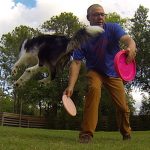 Release has many meanings in disc. Throws and throw variations can be referred to as releases. Sometimes you talk about the dog releasing something, the toy, or the environment, as in to stop... More
Release has many meanings in disc. Throws and throw variations can be referred to as releases. Sometimes you talk about the dog releasing something, the toy, or the environment, as in to stop... More
Notes
The disc will bounce without your pushing the disc down. The momentum of your body dipping will set the disc on a tiny cushion of air. It won’t be huge, but it will be an Airbounce. The further out you lunge, the more of this phenomena will occur. You should not need to push the disc down very hard to accomplish a healthy bounce, as the movement of the body is doing the work. As you get stronger with the basic elements of the skill, you can start to add more downward movement with your disc to make it bounce more, but take it slow. Success is key.
Hybrid Bounce
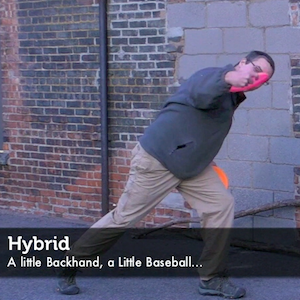 Once you’re reliably bouncing the Backhand Bounce, or if you had some trouble with the backhand bounce, you can move on to the Hybrid Bounce:
Once you’re reliably bouncing the Backhand Bounce, or if you had some trouble with the backhand bounce, you can move on to the Hybrid Bounce:
- Find your target.
- Face your target
- Set the Disc on your Shoulder
- Step 45 degrees towards the target with your off foot (forward and away from throwing hand)
- Clean Release
Notes
This could be a bit tricky. It doesn’t automagically set the disc and body in position for the bounce, but it’s not too bad, good performance of the Backhand Bounce should translate to a decent Hybrid bounce. Whether it’s comfortable or not, that depends on the athlete.
The Hybrid bounce is a very nice bridge between the Backhand Bounce and a more active Baseball kind of bounce. It pretty much is the static version of the Baseball or spinning Airbounce, it’s just not using all the moving parts and does not have as much movement.
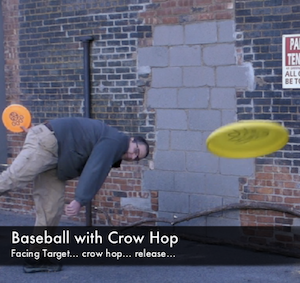 Baseball Bounce
Baseball Bounce
- Find your Target
- Face your target (or off hand 90 degrees to target)
- Set the Disc on your Shoulder
- Weight on back foot
- Step forward with off foot
- Clean Release
Notes
As you can see, we’ve significantly bumped up the number of moving parts in the throw. Adding to this complexity is the fact that not everybody is really fluid with this overhand ball sport mechanics. You can see various degrees of clunkiness in the deliveries of baseball type Airbounces in the sport today and all over youtube. Most people without serious overhand ball sport backgrounds will experience trouble with this delivery.
When you’re starting out, keep your body fairly close to facing the target. As you get better you can start to set up with your off leg more to the front, increasing the distance you have to go to get to that hybrid release position. This is clearly evident if you watch the video closely and is also touched on towards the end of the personal instruction portion.





